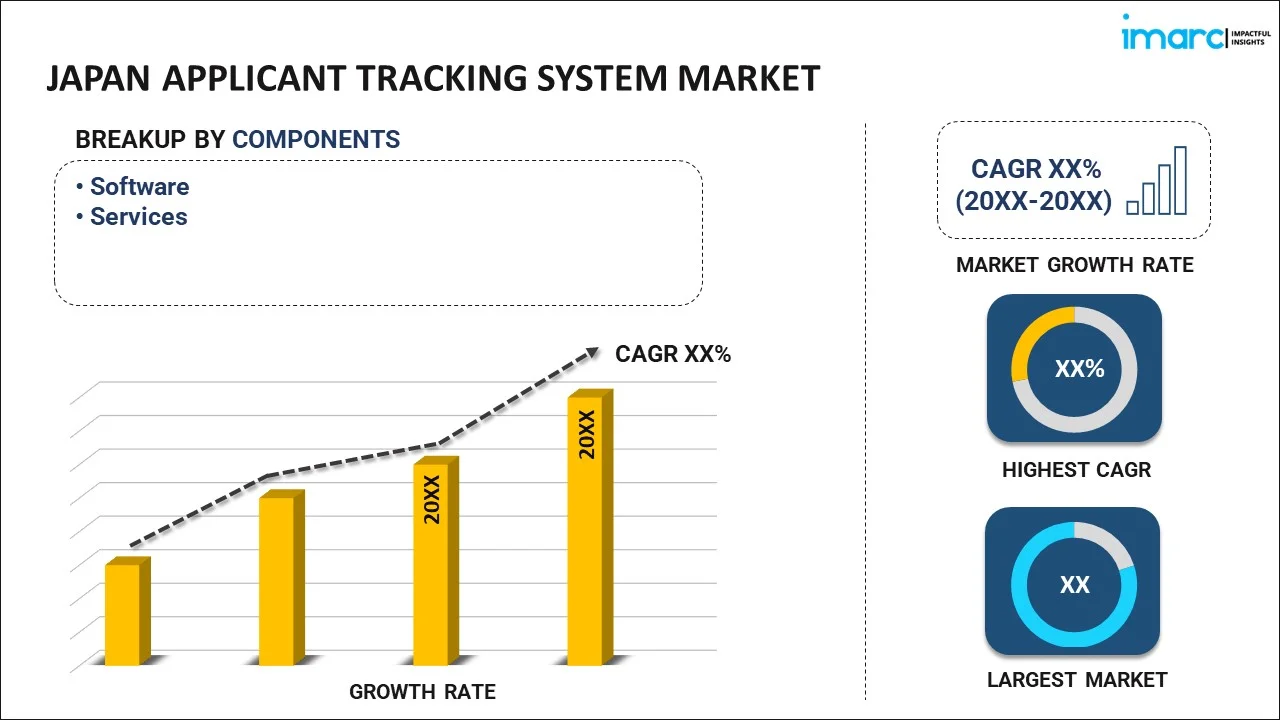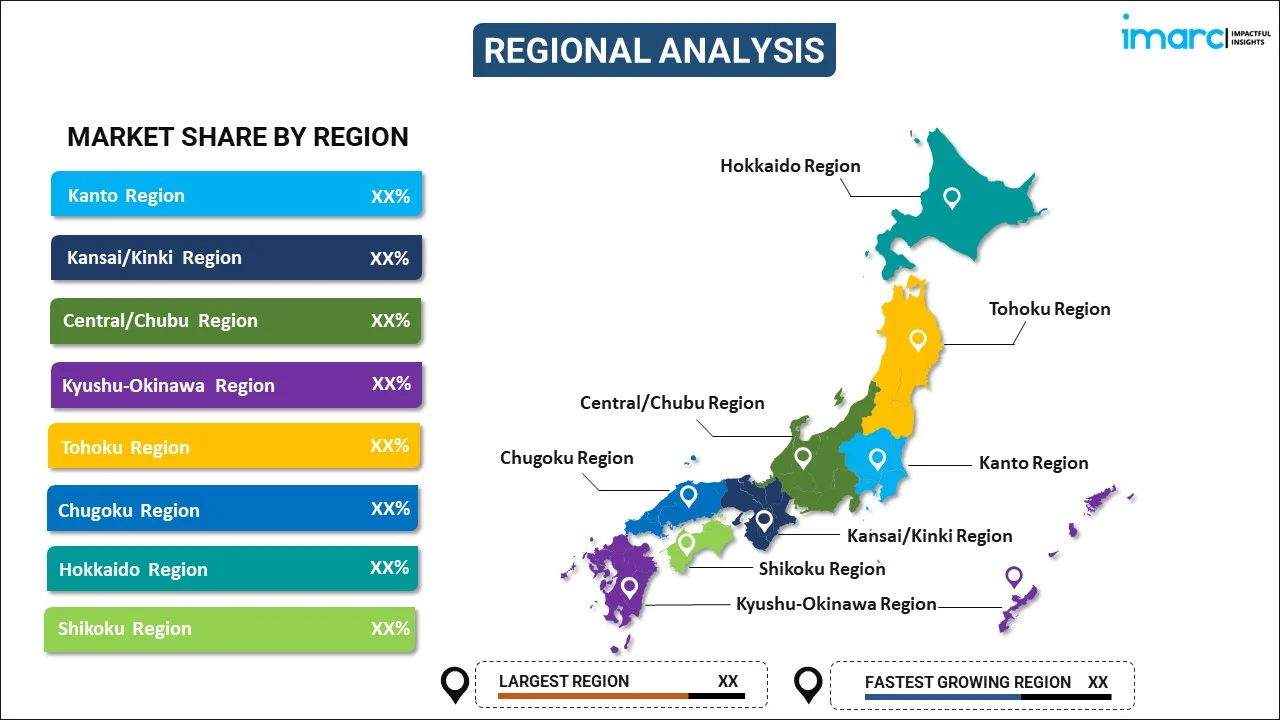
Japan Applicant Tracking System Market Report by Component (Software, Services), Organization Size (Small and Medium-sized Enterprises, Large Enterprises), Deployment (On-premises, Cloud-based), End User (BFSI, IT and Telecommunications, Government and Public Sector, Retail, Manufacturing, Healthcare and Life Sciences, and Others), and Region 2025-2033
Market Overview:
Japan applicant tracking system market size reached USD 172.0 Million in 2024. Looking forward, IMARC Group expects the market to reach USD 304.0 Million by 2033, exhibiting a growth rate (CAGR) of 6.6% during 2025-2033. The rising need for efficient and streamlined recruitment processes, along with the widespread adoption of data-driven insights by businesses to refine their hiring systems, is primarily augmenting the market growth.
|
Report Attribute
|
Key Statistics
|
|---|---|
|
Base Year
|
2024 |
|
Forecast Years
|
2025-2033
|
|
Historical Years
|
2019-2024
|
| Market Size in 2024 | USD 172.0 Million |
| Market Forecast in 2033 | USD 304.0 Million |
| Market Growth Rate (2025-2033) | 6.6% |
An applicant tracking system (ATS) is a software tool for talent management that efficiently manages and tracks job openings, resumes, candidates, and client information within an organization. The software's database helps streamline the hiring process by conducting initial analysis and identifying qualified and suitable candidates for a particular job. ATS enables managers to schedule interviews, send rejection notifications, and manage required paperwork electronically. Its primary objective is to reduce the workload of recruiters while serving as a centralized repository for candidate information. ATS also plays a crucial role in minimizing the time spent on administrative tasks, expediting resume screening, and facilitating collaborative recruitment efforts. In doing so, it enhances the overall experience for candidates involved in the hiring process.
Japan Applicant Tracking System Market Trends:
In the context of the Japanese market, several factors are contributing to market growth. One of the primary drivers is the increasing adoption of cloud-based platforms, coupled with the integration of mobile-based recruitment systems. This trend is significantly boosting the market as organizations increasingly embrace Software-as-a-Service (SaaS) solutions to automate their recruitment and hiring processes. This adoption of SaaS solutions enhances staffing efficiency and productivity, streamlining the process of identifying and hiring suitable candidates. Additionally, ATS systems enable businesses to implement strategic branding initiatives to attract qualified job seekers. Furthermore, the integration of artificial intelligence (AI) into organizational processes is playing a pivotal role in driving market growth. ATS software leverages optical tracking capabilities to monitor applicants and provide precise results. It also identifies market trends and patterns through transactional activities and analytical inputs. Moreover, there is a growing recognition of the need to replace traditional hiring methods in Japan. This shift is driven by the desire to reduce time and cost inefficiencies while simultaneously improving the quality of hiring decisions. These factors collectively will contribute to the expansion of the market in Japan over the forecasted period.
Japan Applicant Tracking System Market Segmentation:
IMARC Group provides an analysis of the key trends in each segment of the market, along with forecasts at the country level for 2025-2033. Our report has categorized the market based on component, organization size, deployment, and end user.
Component Insights:

- Software
- Services
The report has provided a detailed breakup and analysis of the market based on the component. This includes software and services.
Organization Size Insights:
- Small and Medium-sized Enterprises
- Large Enterprises
A detailed breakup and analysis of the market based on the organization size have also been provided in the report. This includes small and medium-sized enterprises and large enterprises.
Deployment Insights:
- On-premises
- Cloud-based
The report has provided a detailed breakup and analysis of the market based on the deployment. This includes on-premises and cloud-based.
End User Insights:
- BFSI
- IT and Telecommunications
- Government and Public Sector
- Retail
- Manufacturing
- Healthcare and Life Sciences
- Others
A detailed breakup and analysis of the market based on the end user have also been provided in the report. This includes BFSI, IT and telecommunications, government and public sector, retail, manufacturing, healthcare and life sciences, and others.
Regional Insights:

- Kanto Region
- Kansai/Kinki Region
- Central/ Chubu Region
- Kyushu-Okinawa Region
- Tohoku Region
- Chugoku Region
- Hokkaido Region
- Shikoku Region
The report has also provided a comprehensive analysis of all the major regional markets, which include Kanto Region, Kansai/Kinki Region, Central/ Chubu Region, Kyushu-Okinawa Region, Tohoku Region, Chugoku Region, Hokkaido Region, and Shikoku Region.
Competitive Landscape:
The market research report has also provided a comprehensive analysis of the competitive landscape. Competitive analysis such as market structure, key player positioning, top winning strategies, competitive dashboard, and company evaluation quadrant has been covered in the report. Also, detailed profiles of all major companies have been provided.
Japan Applicant Tracking System Market Report Coverage:
| Report Features | Details |
|---|---|
| Base Year of the Analysis | 2024 |
| Historical Period | 2019-2024 |
| Forecast Period | 2025-2033 |
| Units | Million USD |
| Scope of the Report | Exploration of Historical and Forecast Trends, Industry Catalysts and Challenges, Segment-Wise Historical and Predictive Market Assessment:
|
| Components Covered | Software, Services |
| Organization Sizes Covered | Small and Medium-sized Enterprises, Large Enterprises |
| Deployments Covered | On-premises, Cloud-based |
| End Users Covered | BFSI, IT and Telecommunications, Government and Public Sector, Retail, Manufacturing, Healthcare and Life Sciences, Others |
| Regions Covered | Kanto Region, Kansai/Kinki Region, Central/ Chubu Region, Kyushu-Okinawa Region, Tohoku Region, Chugoku Region, Hokkaido Region, Shikoku Region |
| Customization Scope | 10% Free Customization |
| Post-Sale Analyst Support | 10-12 Weeks |
| Delivery Format | PDF and Excel through Email (We can also provide the editable version of the report in PPT/Word format on special request) |
Key Questions Answered in This Report:
- How has the Japan applicant tracking system market performed so far and how will it perform in the coming years?
- What has been the impact of COVID-19 on the Japan applicant tracking system market?
- What is the breakup of the Japan applicant tracking system market on the basis of component?
- What is the breakup of the Japan applicant tracking system market on the basis of organization size?
- What is the breakup of the Japan applicant tracking system market on the basis of deployment?
- What is the breakup of the Japan applicant tracking system market on the basis of end user?
- What are the various stages in the value chain of the Japan applicant tracking system market?
- What are the key driving factors and challenges in the Japan applicant tracking system?
- What is the structure of the Japan applicant tracking system market and who are the key players?
- What is the degree of competition in the Japan applicant tracking system market?
Key Benefits for Stakeholders:
- IMARC’s industry report offers a comprehensive quantitative analysis of various market segments, historical and current market trends, market forecasts, and dynamics of the Japan applicant tracking system market from 2019-2033.
- The research report provides the latest information on the market drivers, challenges, and opportunities in the Japan applicant tracking system market.
- Porter's five forces analysis assist stakeholders in assessing the impact of new entrants, competitive rivalry, supplier power, buyer power, and the threat of substitution. It helps stakeholders to analyze the level of competition within the Japan applicant tracking system industry and its attractiveness.
- Competitive landscape allows stakeholders to understand their competitive environment and provides an insight into the current positions of key players in the market.
Need more help?
- Speak to our experienced analysts for insights on the current market scenarios.
- Include additional segments and countries to customize the report as per your requirement.
- Gain an unparalleled competitive advantage in your domain by understanding how to utilize the report and positively impacting your operations and revenue.
- For further assistance, please connect with our analysts.
 Inquire Before Buying
Inquire Before Buying
 Speak to an Analyst
Speak to an Analyst
 Request Brochure
Request Brochure
 Request Customization
Request Customization




.webp)




.webp)












